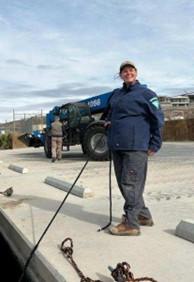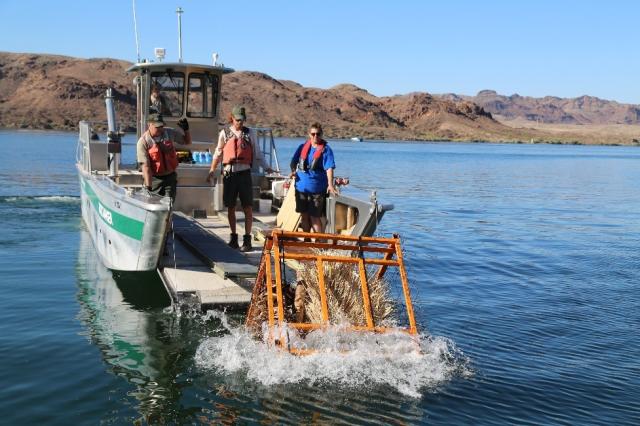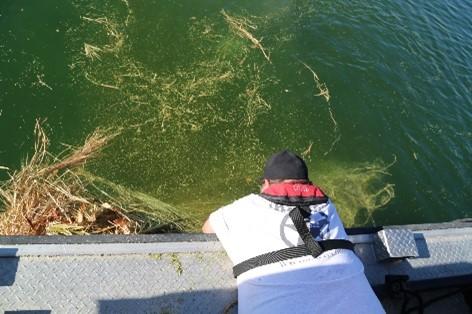Lake Havasu Fisheries Improvement Program: Thirty years of stewardship, science, and community

Lake Havasu is famous for striped bass, redear sunfish, world-class tournaments, and unforgettable days on the water. But behind that success is a program most people never see, that has quietly shaped the lake’s fisheries.
For more than three decades, the Lake Havasu Fisheries Improvement Program has strengthened the lake’s aquatic habitat, improved recreational fishing, and supported the local economy. The program has turned Lake Havasu into one of the nation’s top fisheries.
Led by Bureau of Land Management (BLM) Arizona Lake Havasu field office fisheries biologist Rachel Wirick, the partnership includes federal, state, and local organizations and a core group of dedicated volunteers who make the work possible.
"The BLM Colorado River District is overjoyed to have a fisheries biologist as knowledgeable and committed to the preservation and conservation of this very unique aquatic habitat as Rachel," Lake Havasu field office manager Amanda Dodson said. "She is a true example of the passion, dedication, and integrity required to develop and foster community level partnerships that will serve the agency, community and the lands and waterways that BLM are responsible for overseeing in our area well into the future."
As we mark World Fisheries Day, we’re highlighting the people behind the program —especially the volunteers who show up week after week to build habitat, load boats, install habitat structures, and keep the lake thriving.
Partnership continues to deliver
The Lake Havasu Fisheries Improvement Program was created in 1992 to address declining fish habitat and angler success. Today, the program is stronger than ever, thanks to a coalition of agencies, nonprofits, and local volunteers who show up, gear up, and get the work done. And now, the team is welcoming new volunteers to join the next chapter.
Agencies and organizations include:
Bureau of Land Management
Bureau of Reclamation
U.S. Geological Survey
U.S. Fish and Wildlife Service
Arizona Game and Fish Department
Arizona State Parks and Trails
California Department of Fish and Wildlife
Anglers United
Lake Havasu Marine Association
Lake Havasu Divers Association
Together, these partners plan and install habitat, conduct scientific studies, design new structures, collect Christmas trees to be installed for habitat, and support the day-to-day operations that keep the lake healthy and productive.
It’s a clear example of government agencies, conservation groups, and the public working side-by-side to create a resource that benefits everyone.
Science behind the habitat work

Lake Havasu is an artificial reservoir — beautiful, deep, and productive, but lacking the natural woody structure that fish rely on. Without intervention the habitat would collapse over time. The program prevents that by building habitat from the bottom up using: Habitat does three critical things:
Feeds the food chain: Algae and zooplankton grow on decomposing brush, supporting shad and young fish.
Creates shelter: Small fish hide in the gaps left as leaves decompose, improving survival rates.
Attracts sportfish: Bass, catfish, and other game species hunt around installed habitat, improving angler success.
Each year, the team builds and installs up to 800 brush bundles, representing roughly 90 acres of enhanced aquatic habitat.
Volunteers keep it running

The heart of the program is an enthusiastic volunteer team — mostly retired anglers — who commit their time, skills, and physical effort to keep the program moving.
Jim Hatter

A volunteer since 2018, Jim brings decades of experience and humor to the yard. A retired U.S. Department of Transportation manager, he sees the program as a true “public-private partnership.” Jim volunteers at many levels in the program, helping with building the habitat bundles, filling sandbags, operating equipment that loads the boat and is certified as a Department of the Interior (DOI) boat operator to install the habitat.
Jim says the camaraderie is what keeps him coming back.
“It’s a bunch of guys like myself working together and enjoying what we’re doing. The volunteers and the community make this program work,” Jim said.
He also points to the program’s local economic impact. The Lake Havasu Fisheries Improvement Program has generated significant, long-term economic benefits for the Lake Havasu area — through increased angler visitation, local spending, employment, and tax revenues.
Mike Casey
A retired engineer and former chief systems engineer for the F-18 radar program, Mike learned about the partnership through Anglers United.
For him, the most rewarding part is driving the federal brush boat — after completing the DOI boat-operator certification.
“Being on the water in the morning is the reward. It’s beautiful. And I like giving back. I’m fortunate. This lets me do something meaningful,” Mike said.
Mike also emphasizes the physical demands of the work and the urgent need for new volunteers.
“We need more volunteers, especially some younger guys. Our team works extremely hard, and some fresh bodies would make a huge difference,” Mike said.
Scott Brown
Scott, a fisherman and volunteer for both Anglers United and the Lake Havasu Marine Association, is a regular in the yard and on the boat.
He enjoys the hands-on work most, especially installing habitat.
“It’s good to see exactly where the habitat goes and how it supports the lake. We’re feeding it from the bottom up. It’s a chain of events that benefits everything.”
Scott says the program’s impact extends far beyond fishing.
“The fishing brings people here. Guides, tournaments, tackle shops — they all depend on a healthy lake. This program helps the whole community,” Scott said.
Volunteers matter now more than ever
The program has the expertise. It has the scientific foundation. It has an effective partnership.
What it needs is more volunteers.
Many of the long-time volunteers are now in their 70s and 80s. The physical work — carrying sandbags, loading brush, securing bundles in the water — requires strength and stamina.
Without new volunteers, the number of bundles installed each year will continue to decline. In 2024, only about 550 bundles were installed. In past years, that number reached 800.

Volunteering with the Fisheries Improvement Program means:
Working on the lake in a beautiful setting
Joining a tight-knit, supportive team
Learning about fisheries, habitat, and conservation
Supporting a program that has shaped Lake Havasu for 30+ years
Giving back to the community in a visible, meaningful way
If you enjoy the outdoors, want to help your community, or simply like working with your hands, this is one of the most rewarding ways to make a difference in Lake Havasu.
How to get involved
Those interested in volunteering can contact the BLM Lake Havasu Field Office or reach out through Anglers United or the Lake Havasu Marine Association. Volunteers can contribute as little as a few hours a week.
The lake benefits. The community benefits. And the volunteers benefit.
As Rachel Wirick puts it: “We’re standing at the front of a long line of people who came before us — and hopefully a long line of people who will continue after us.”
On this World Fisheries Day, we celebrate the people who sustain Lake Havasu’s fisheries. And we invite the next generation of volunteers to join them.
Jason VanBuskirk, Public Affairs Specialist
Related Stories
- Stewardship and smiles at Samoa Dunes: BLM California hosts National Public Lands Day event
- Lake Havasu Fisheries Improvement Program is the gift that keeps giving
- BLM is thankful for public lands volunteers
- Agua Fria National Monument: A desert oasis with a rich history and a vital present
- Building for birds: Scouts support public lands
Office
1785 Kiowa Ave.
Lake Havasu City, AZ 86403
United States
